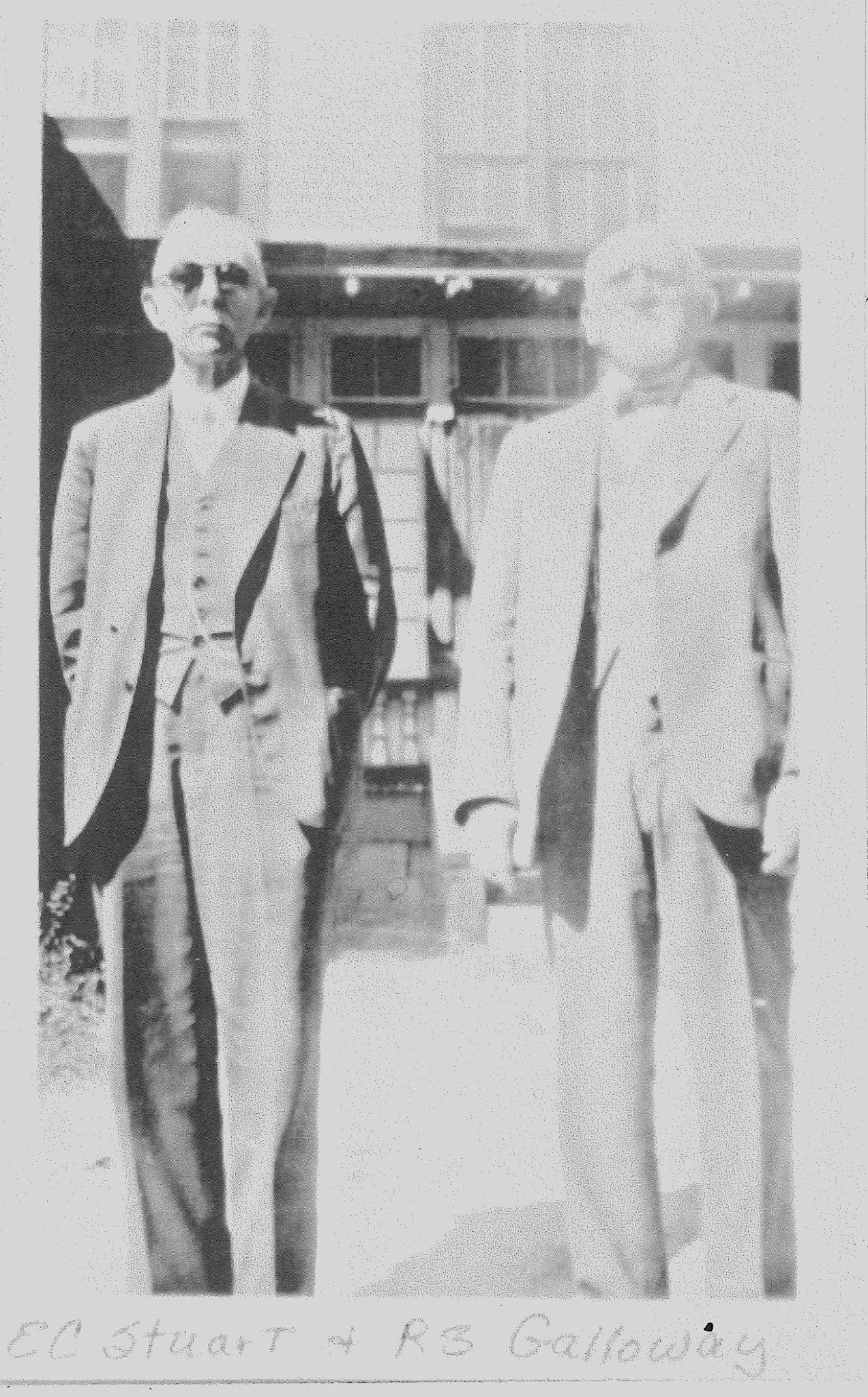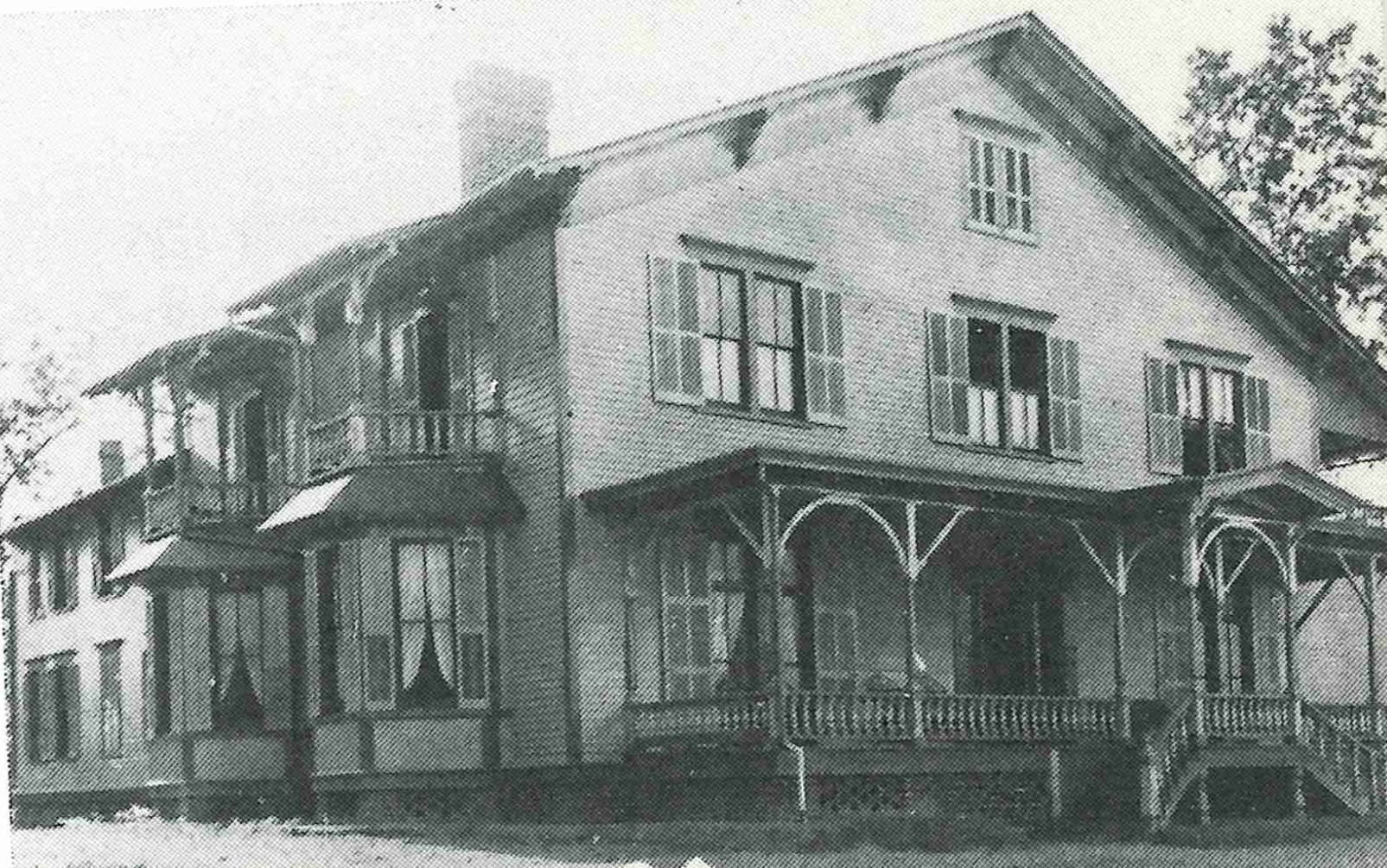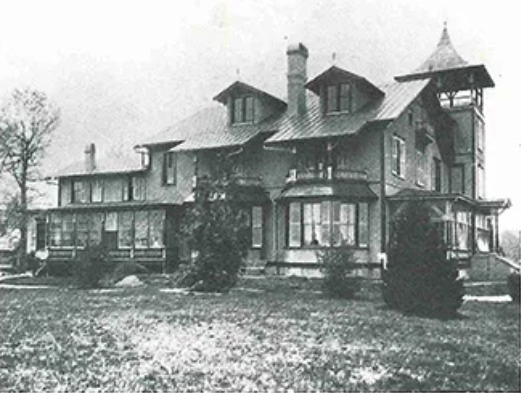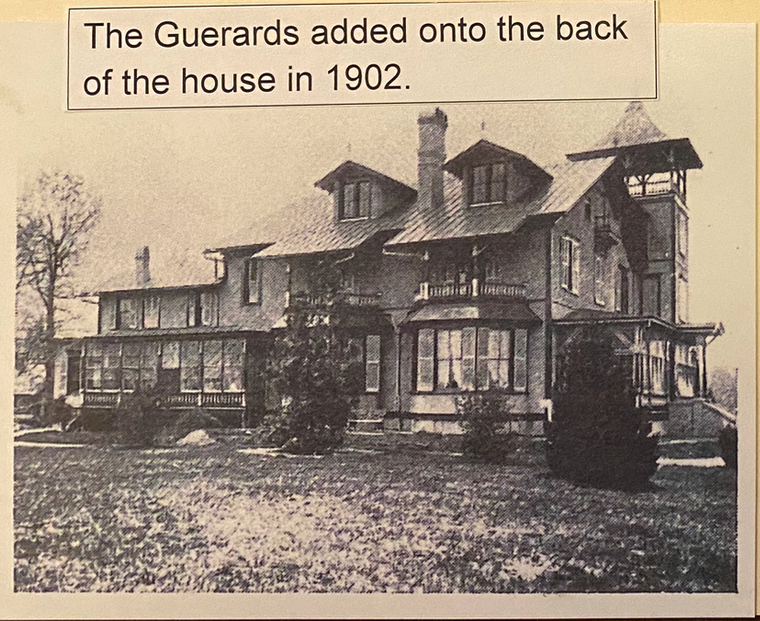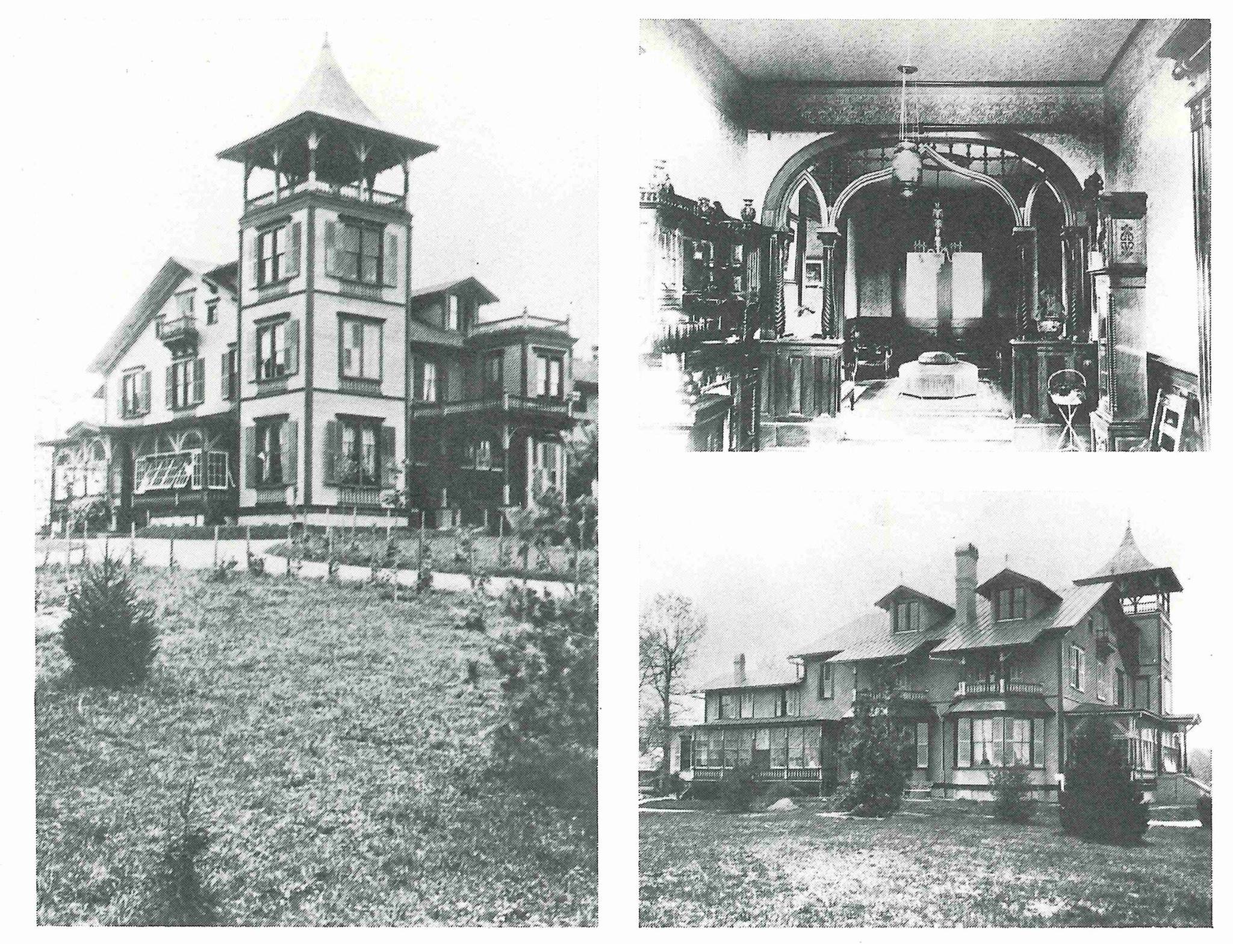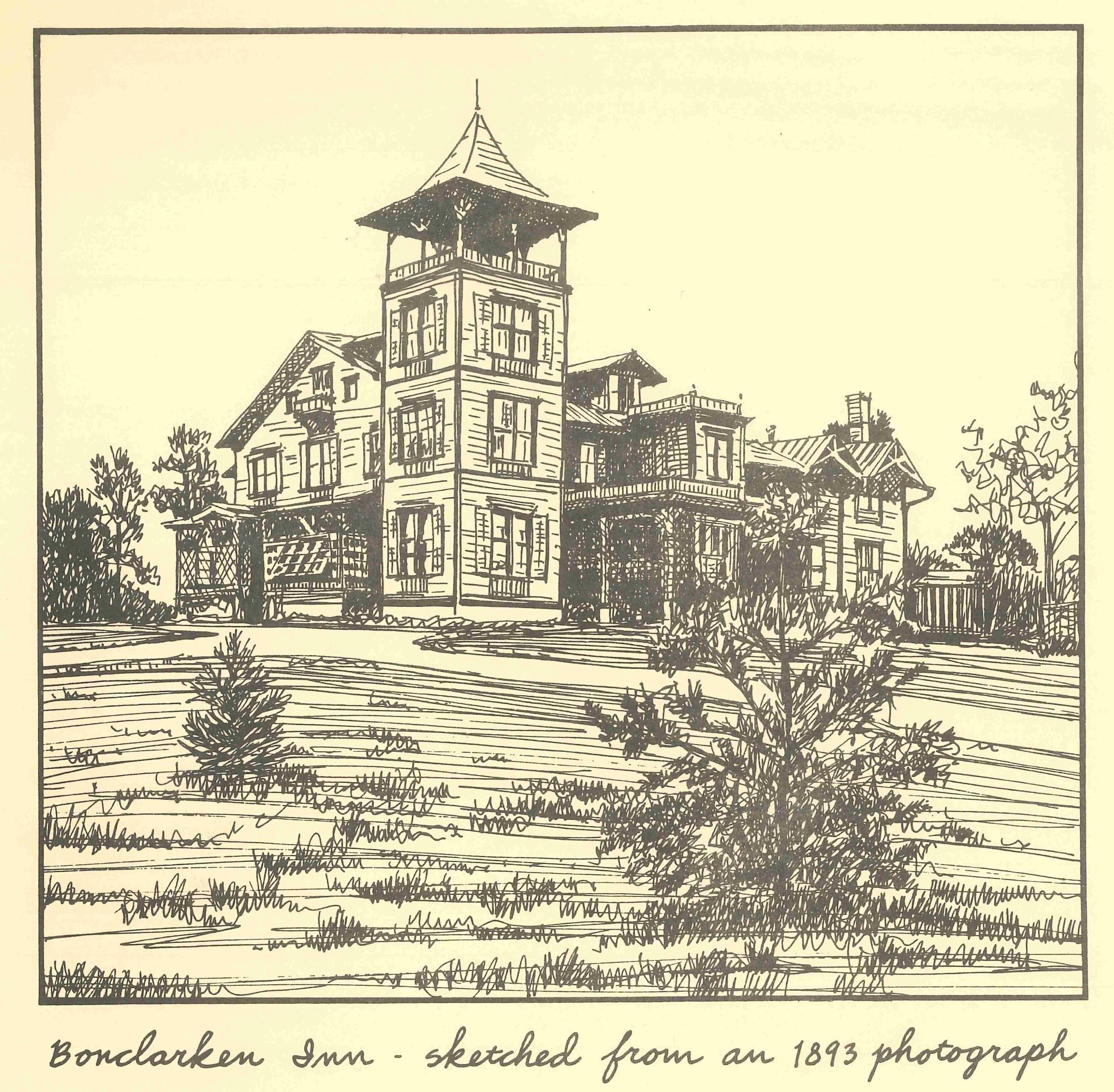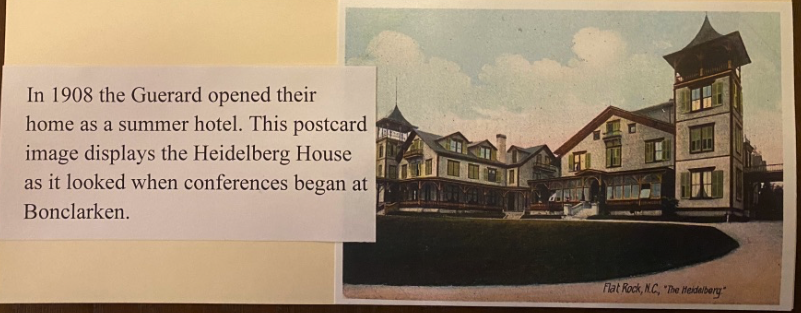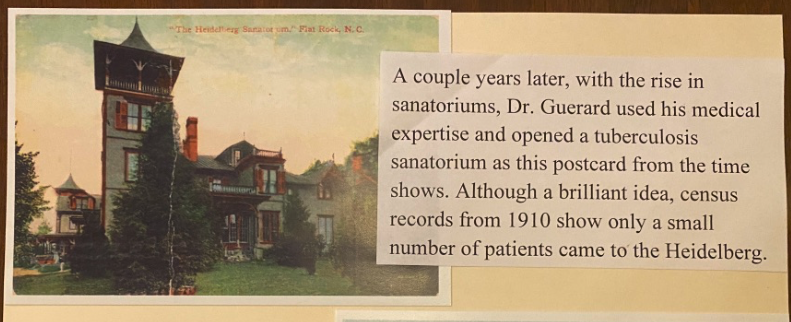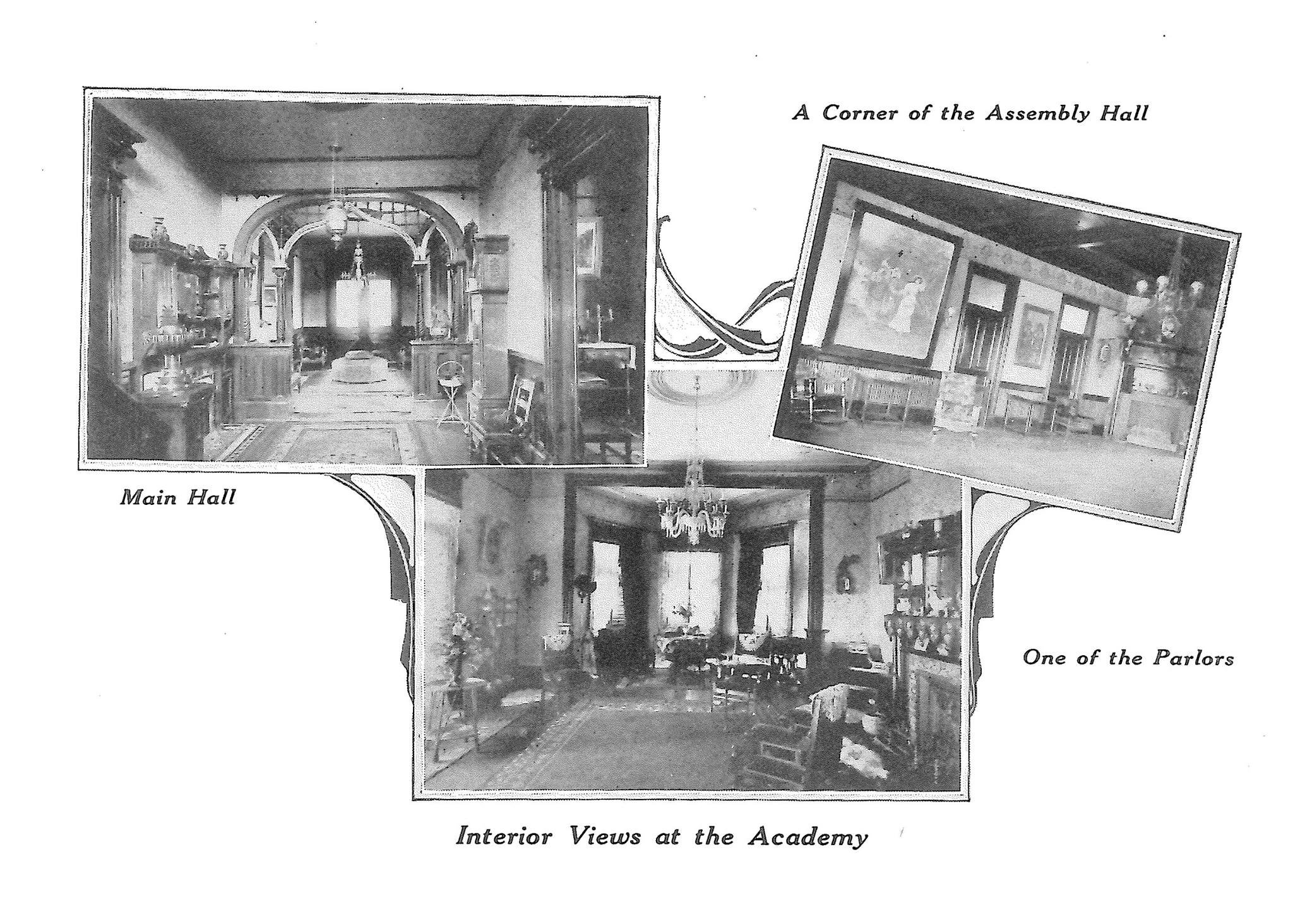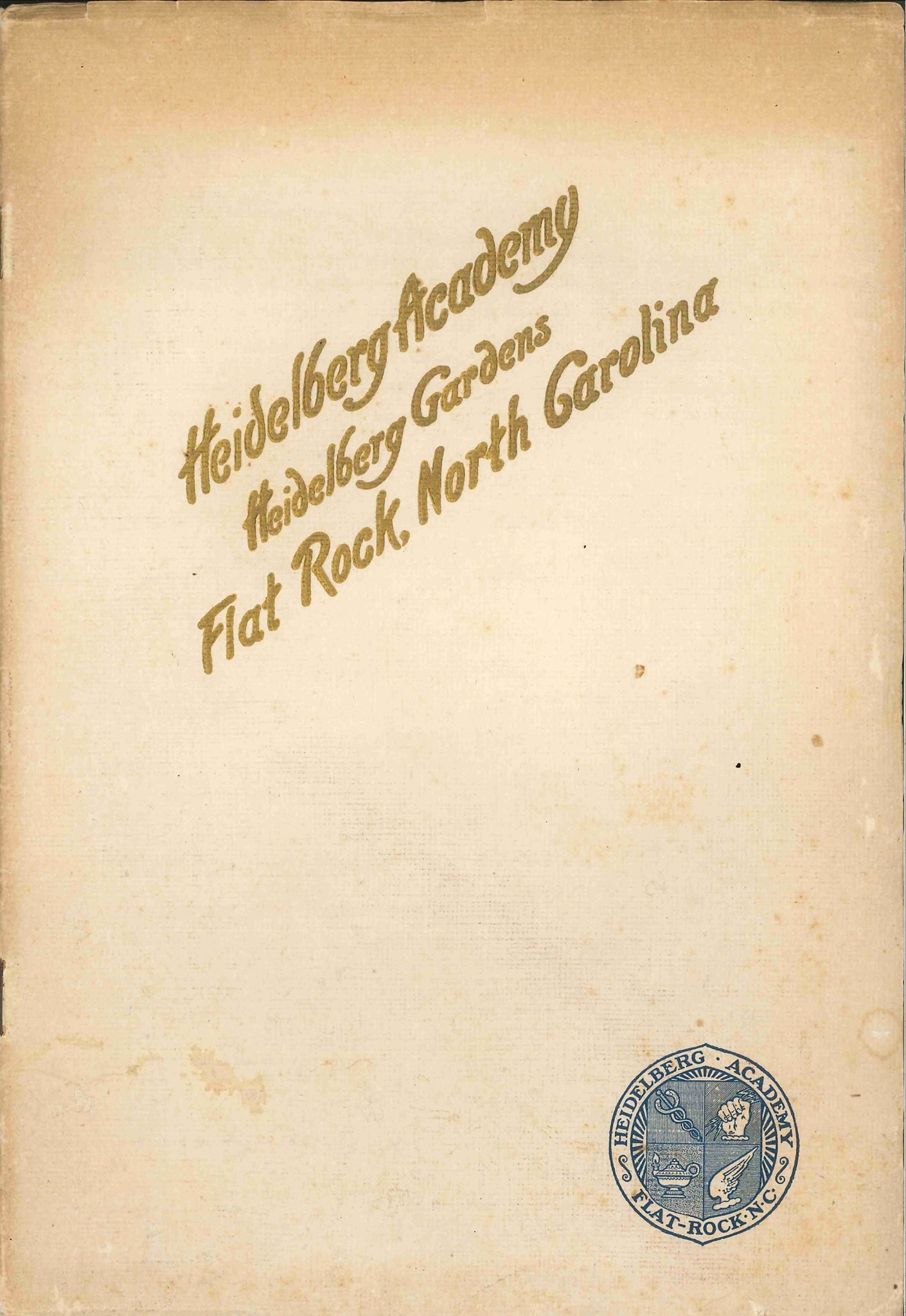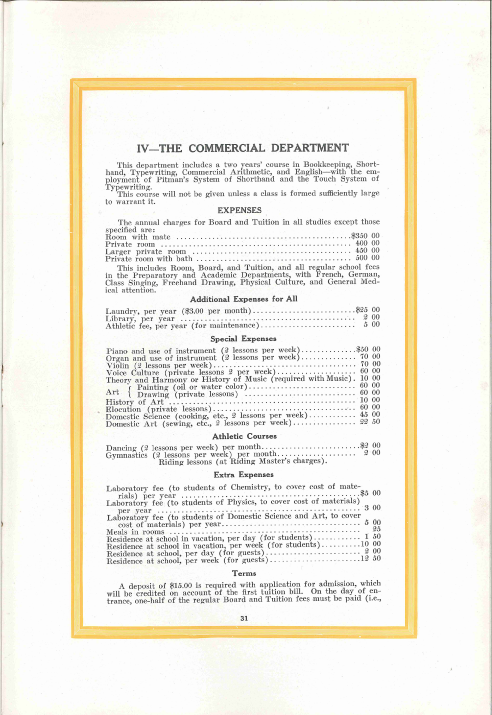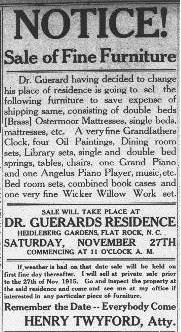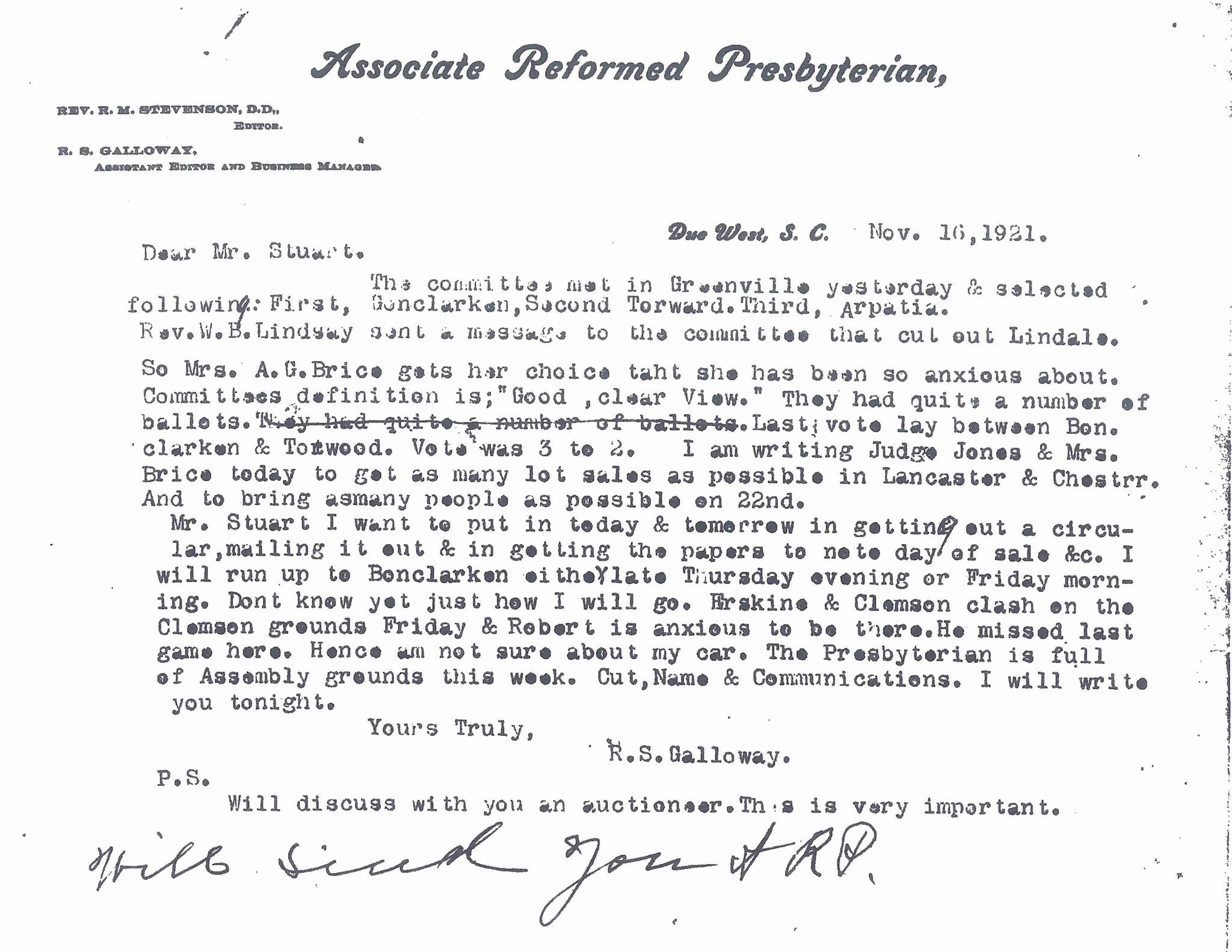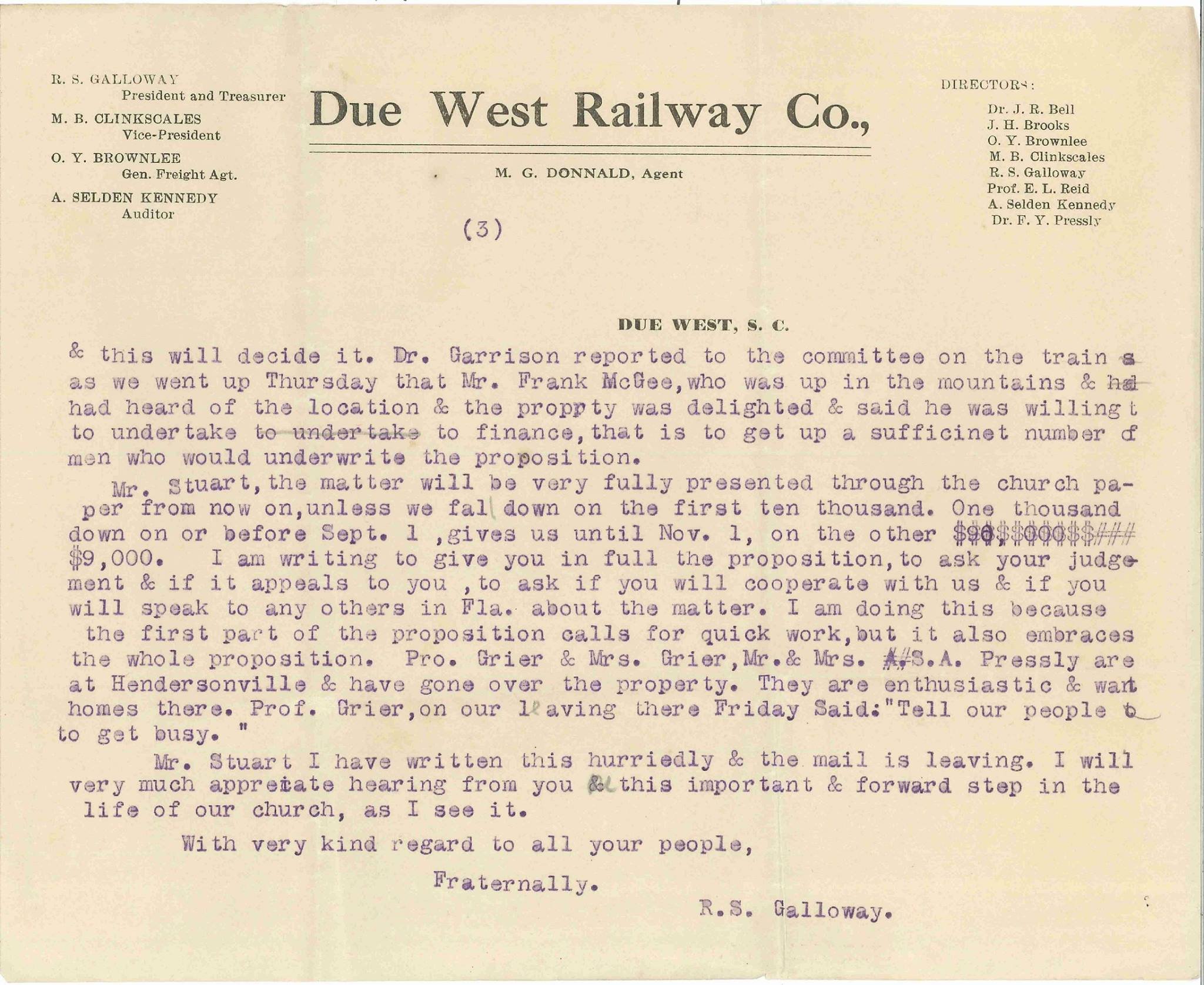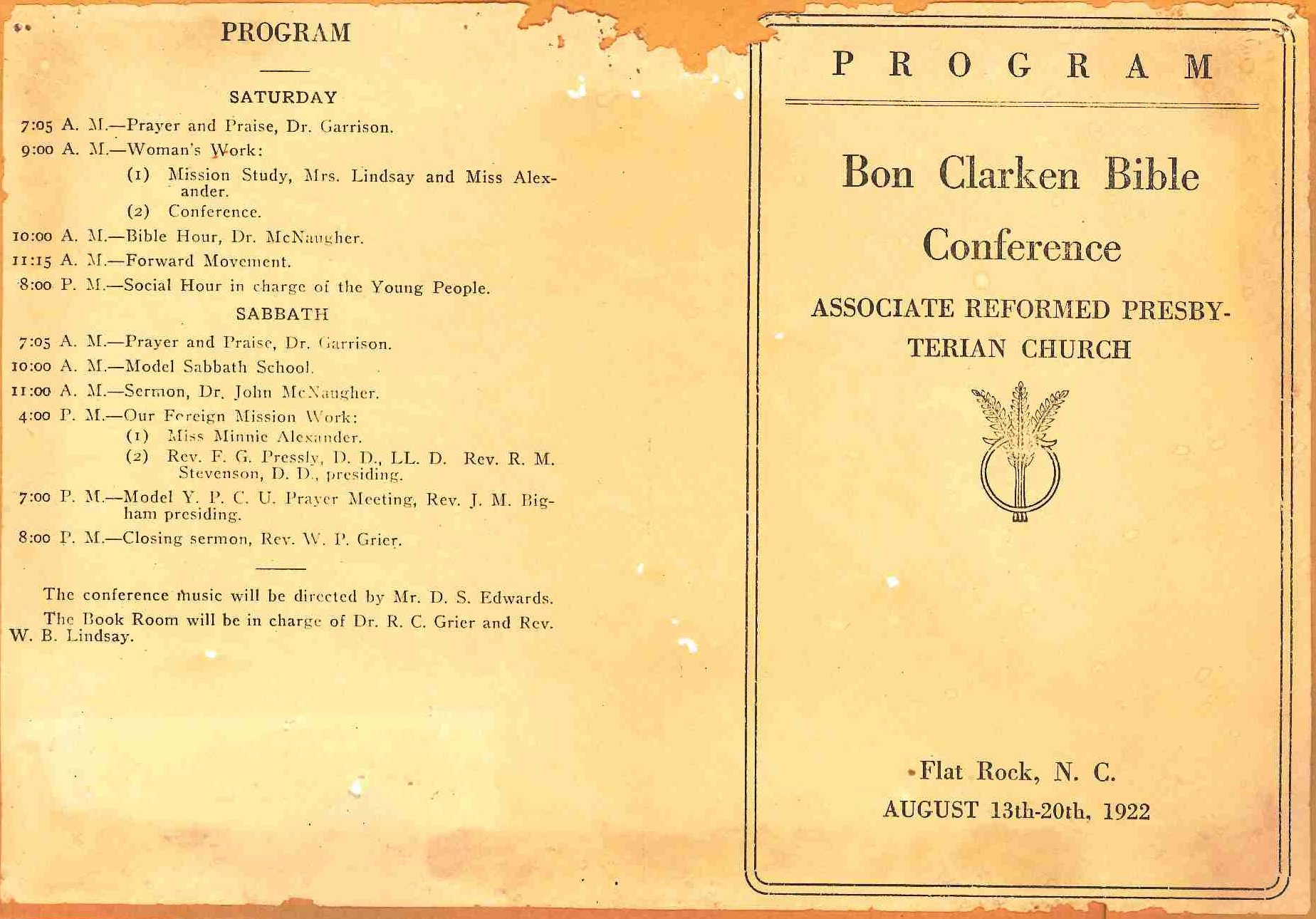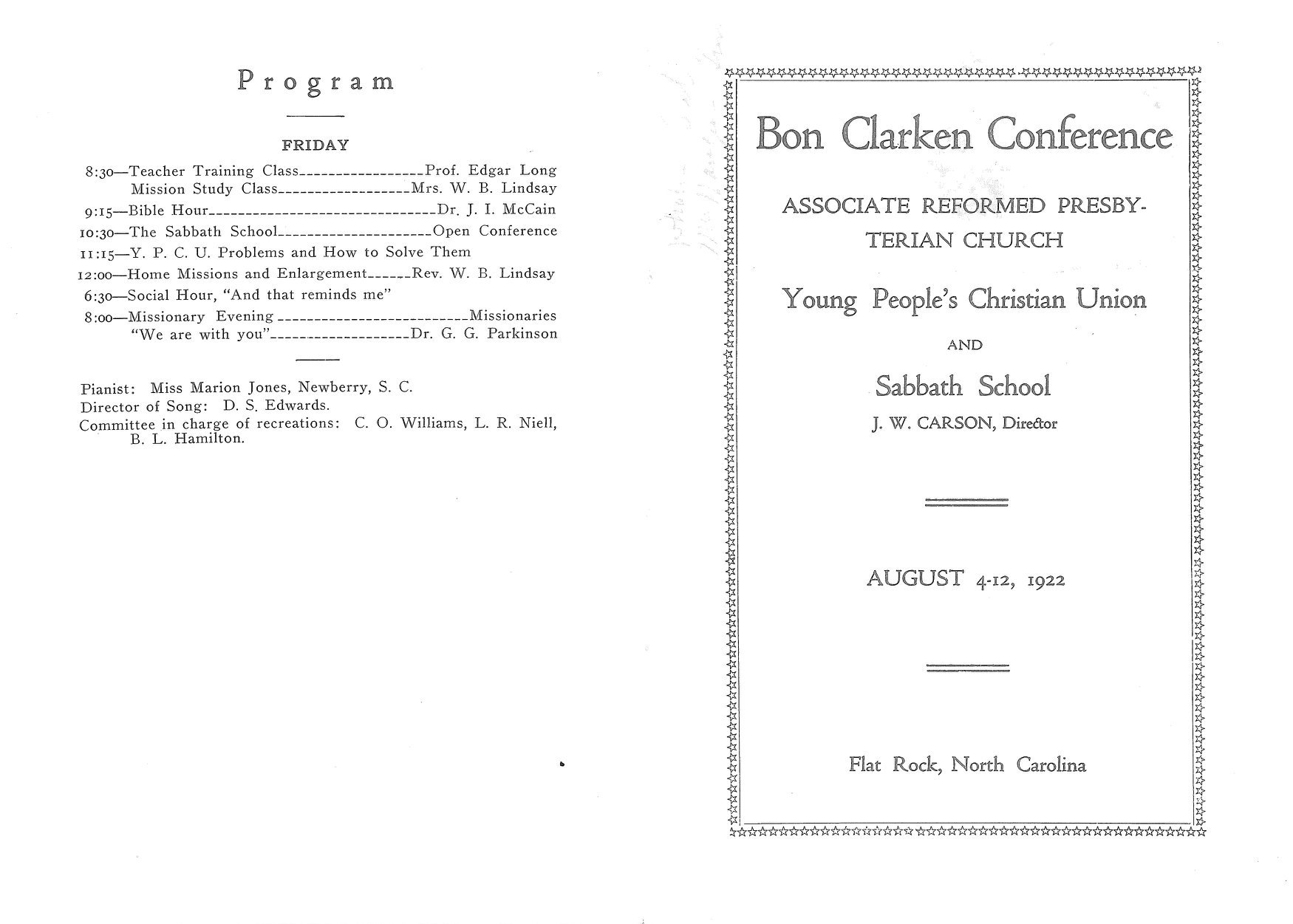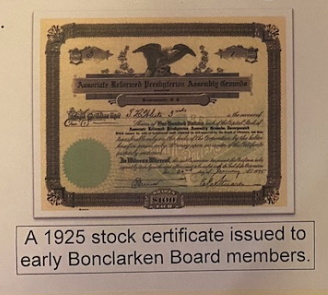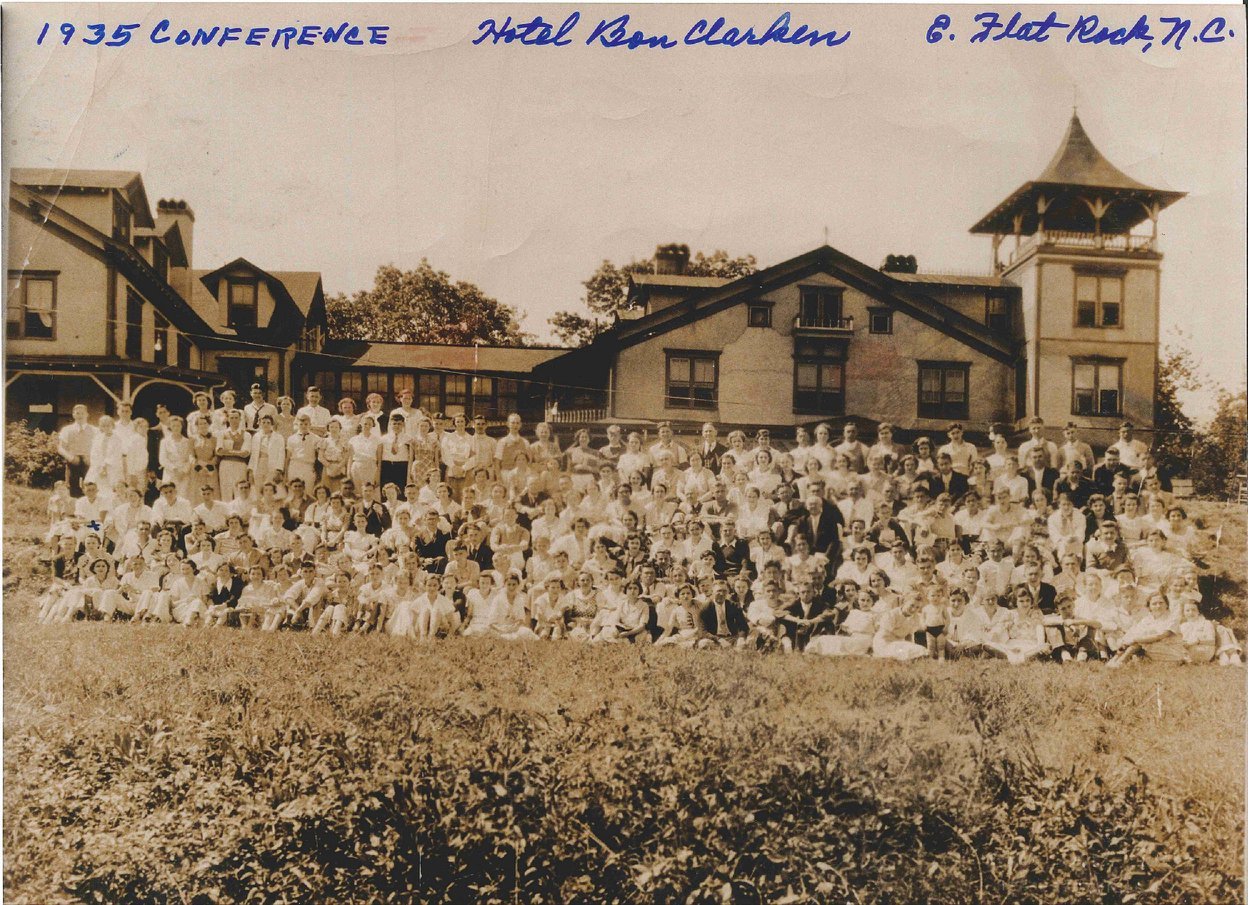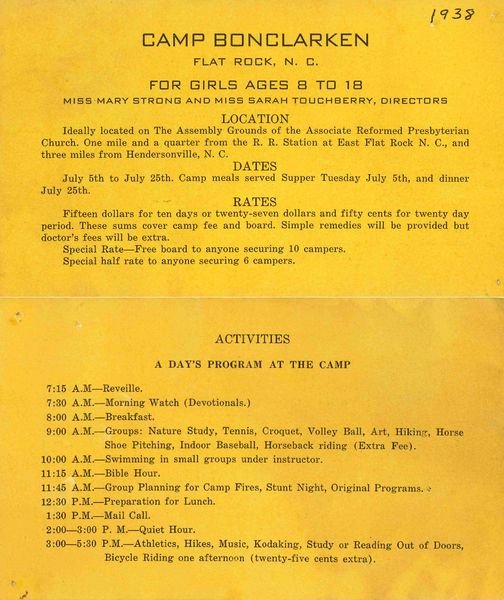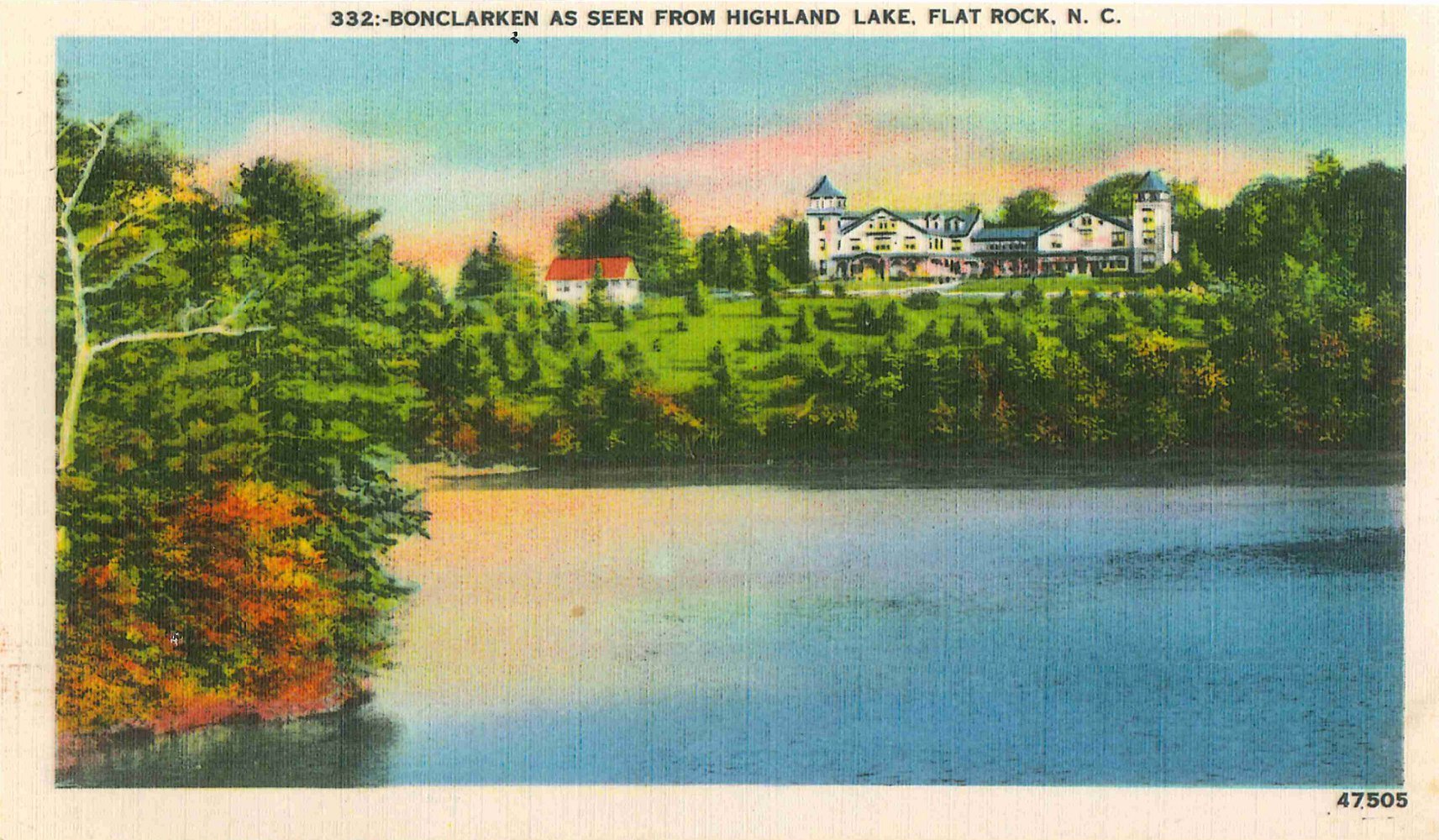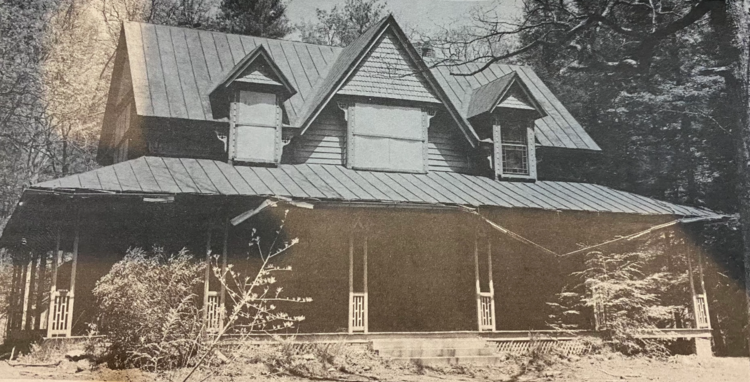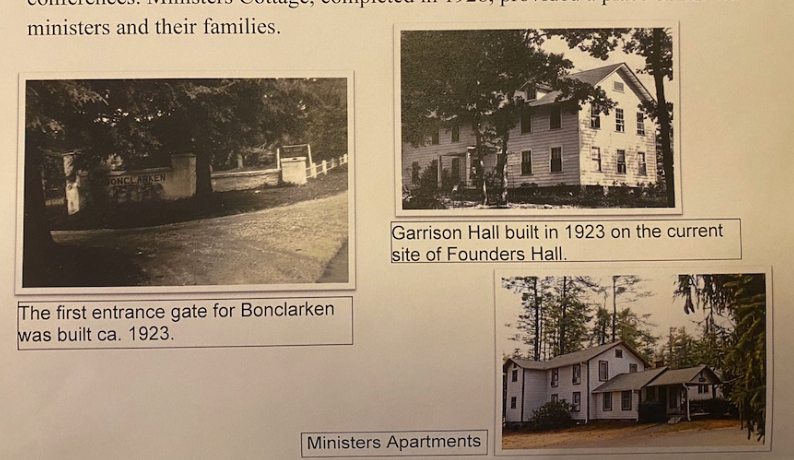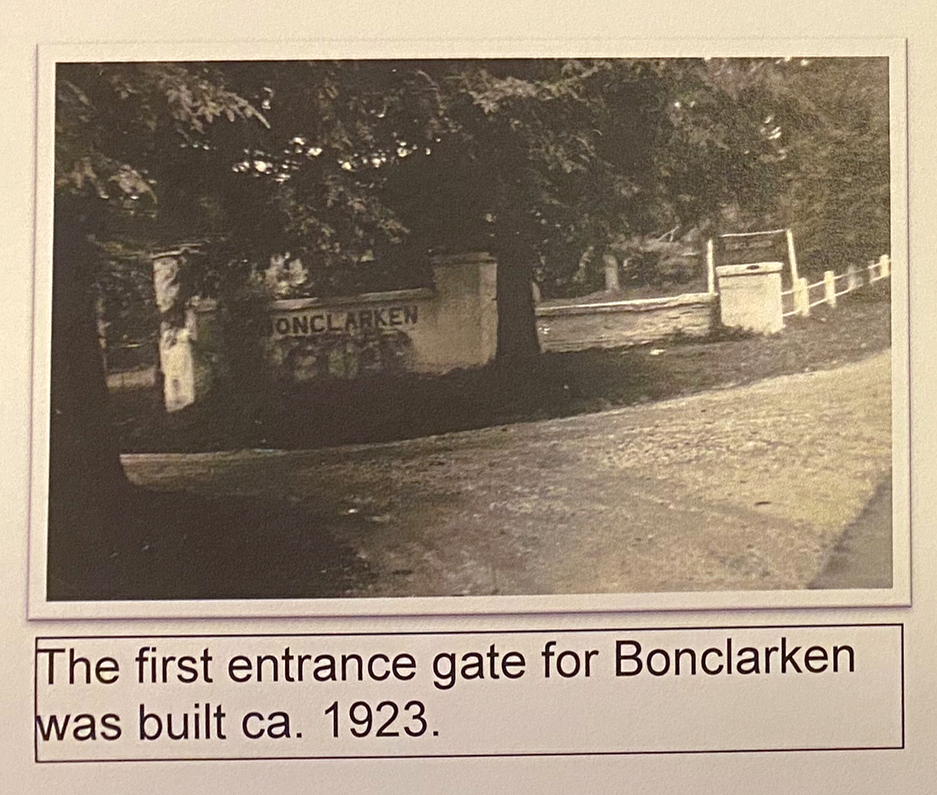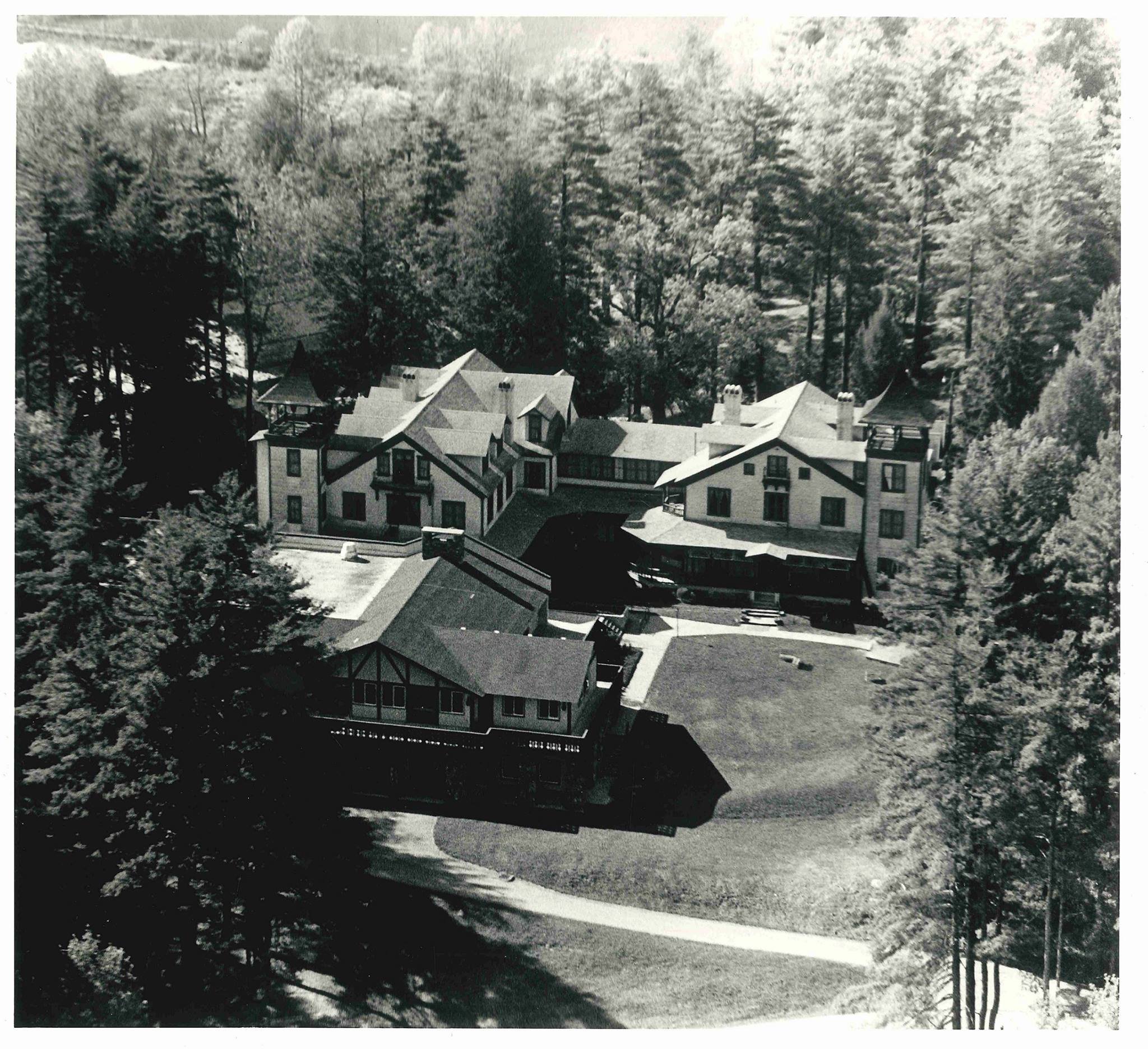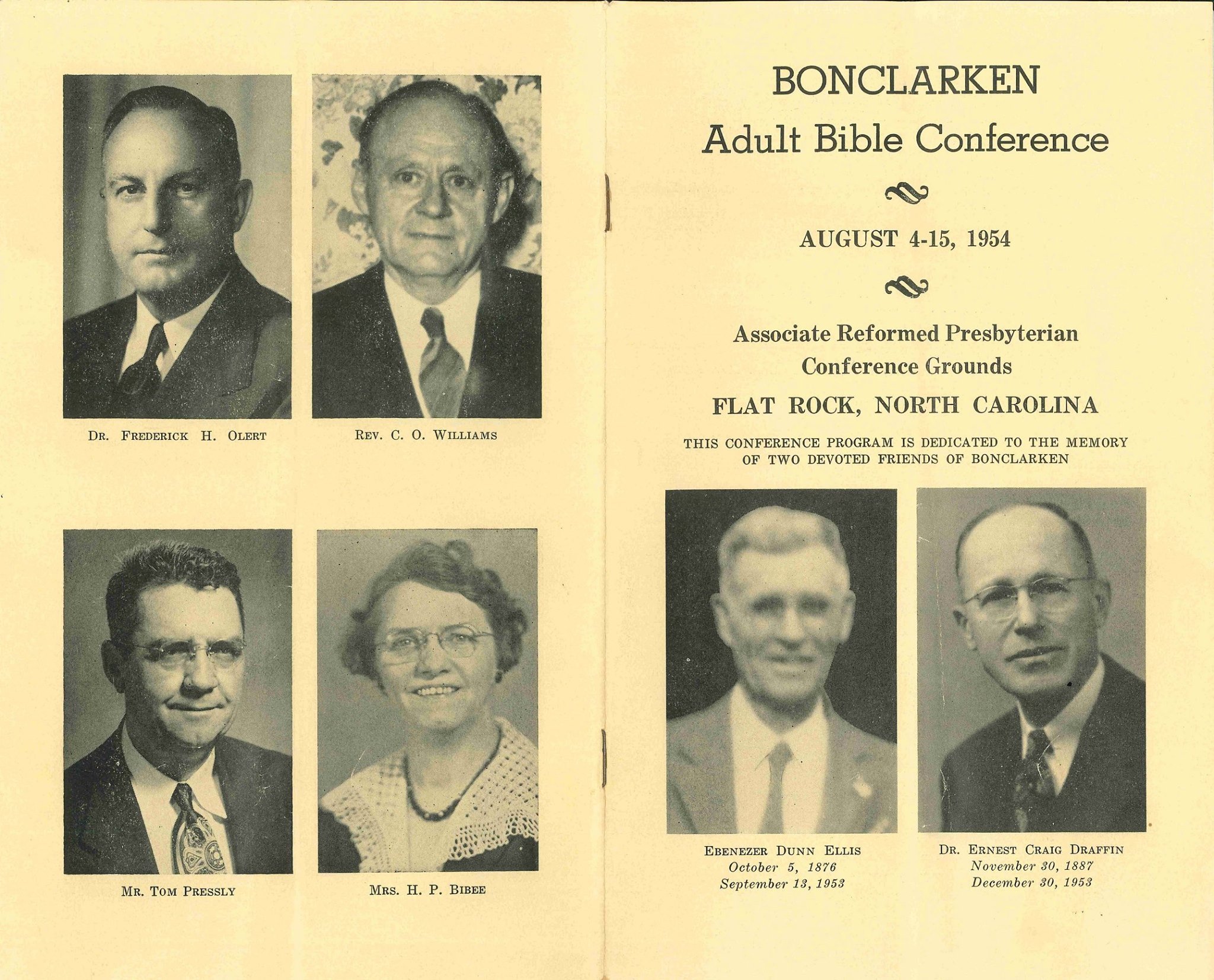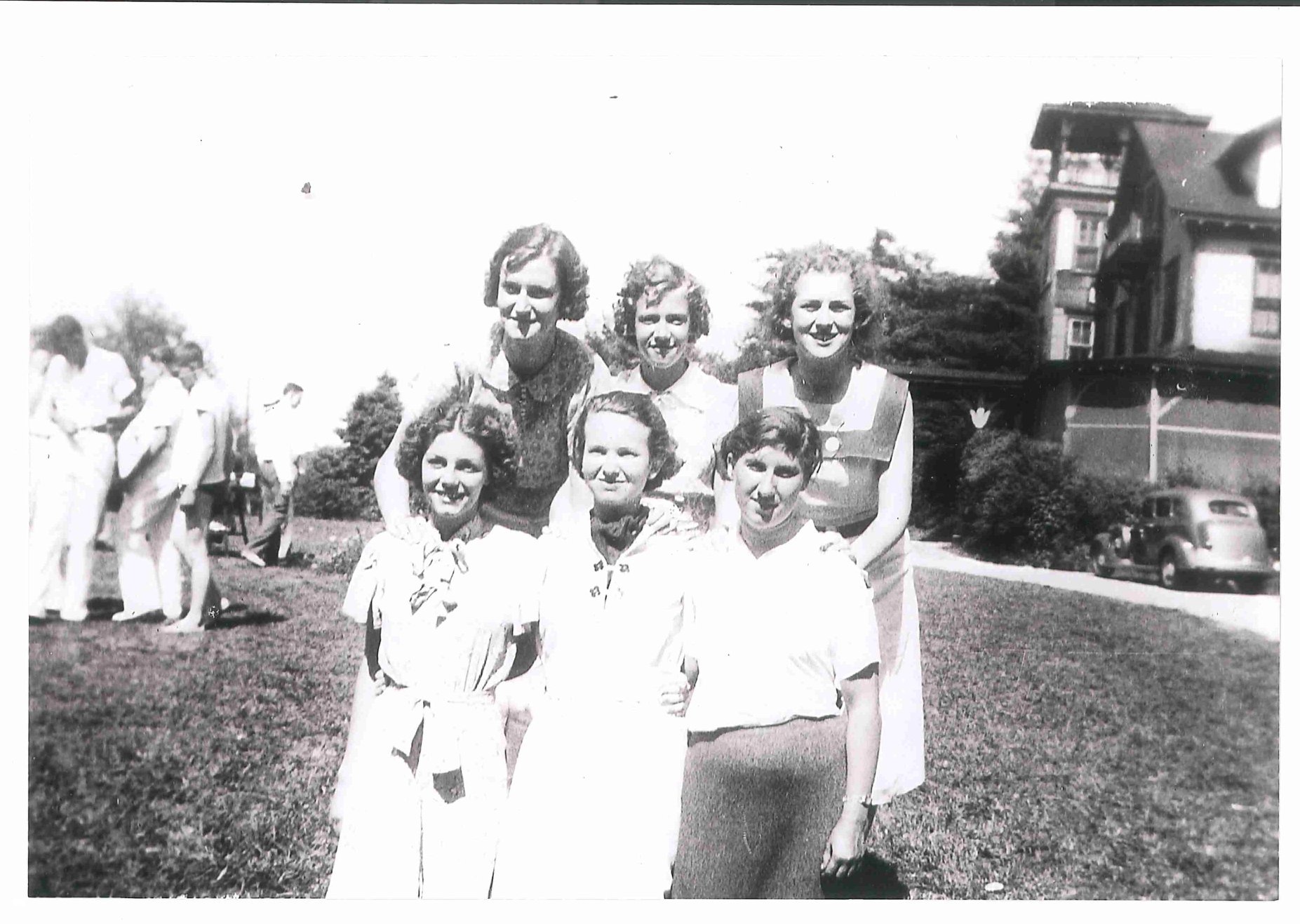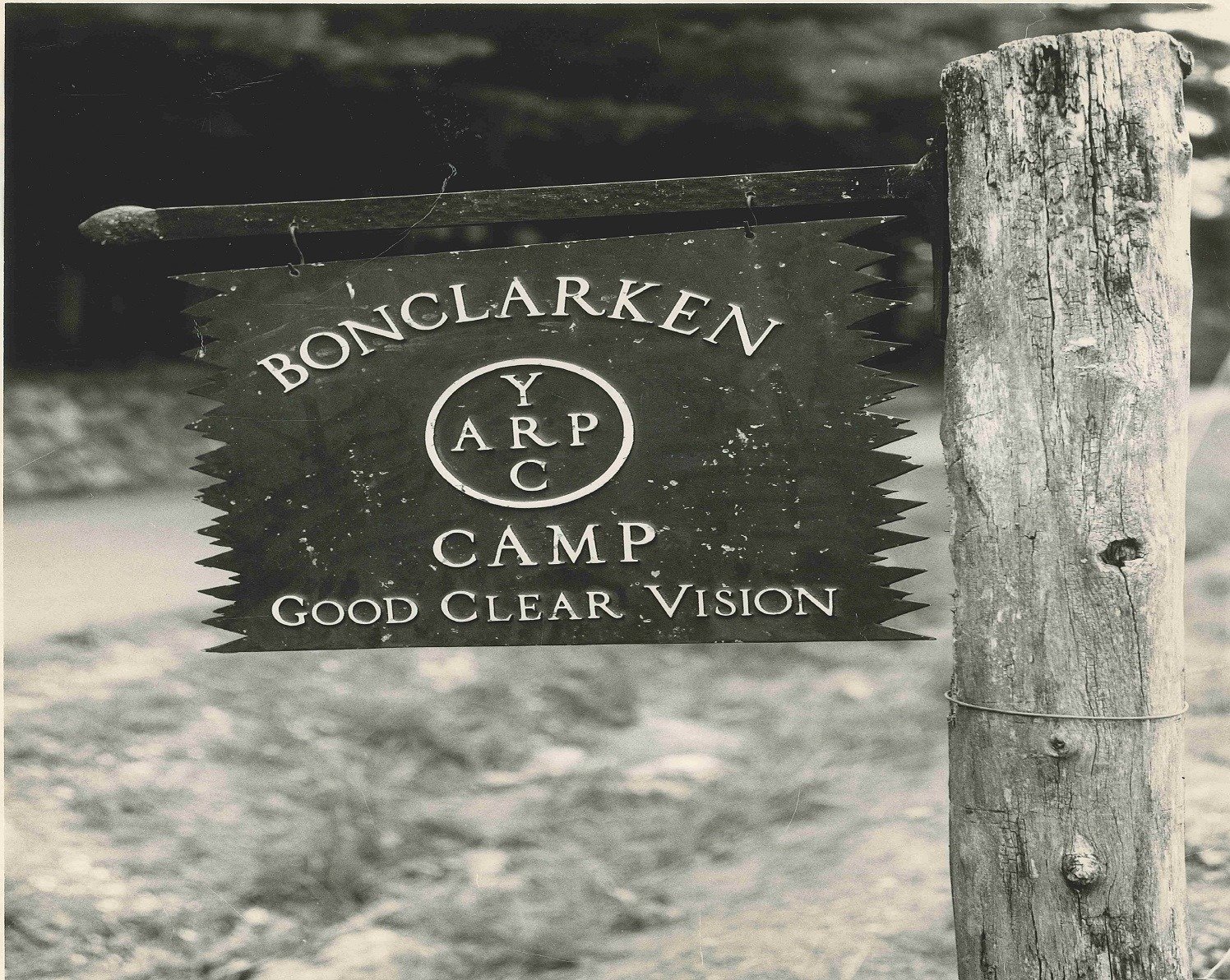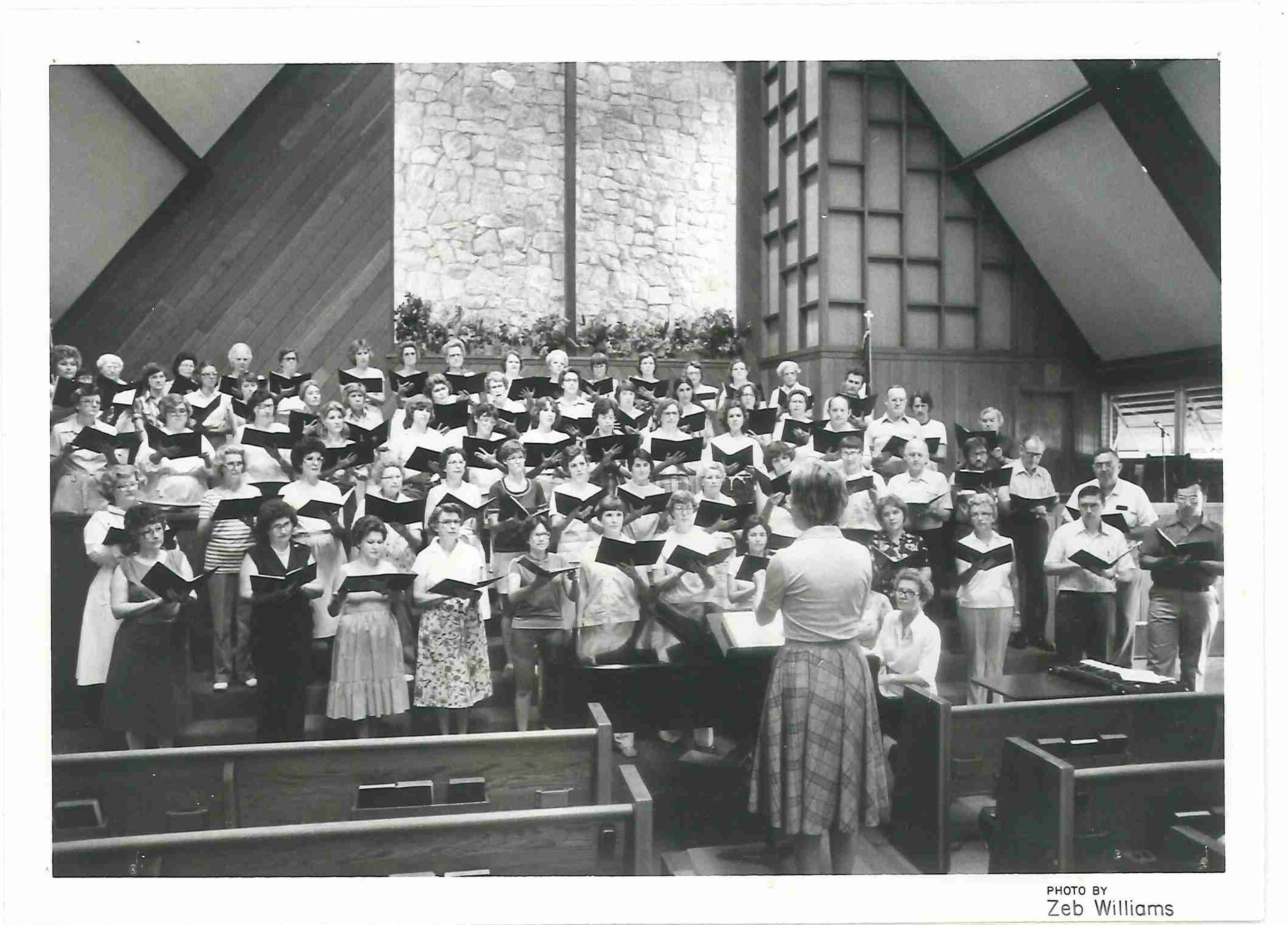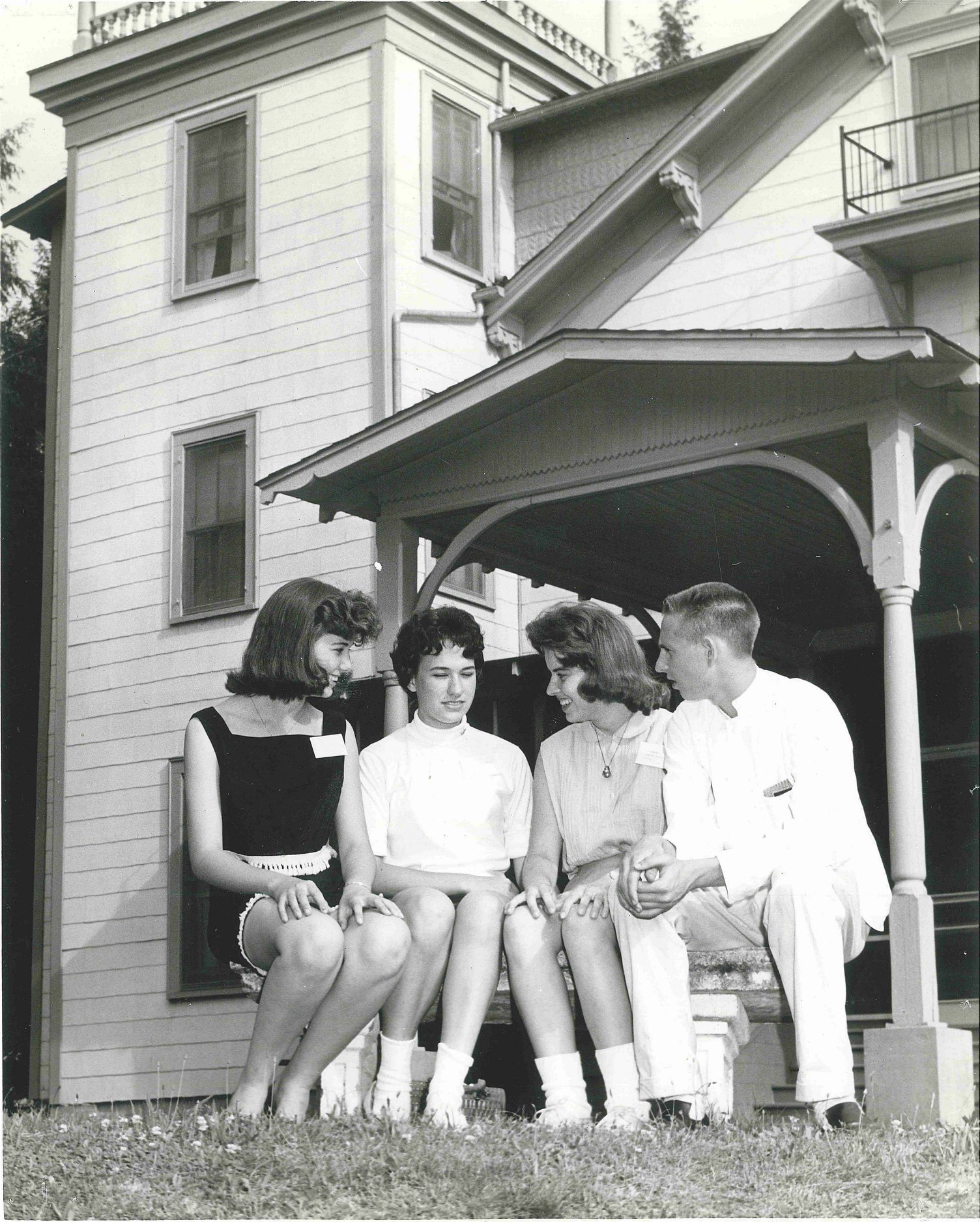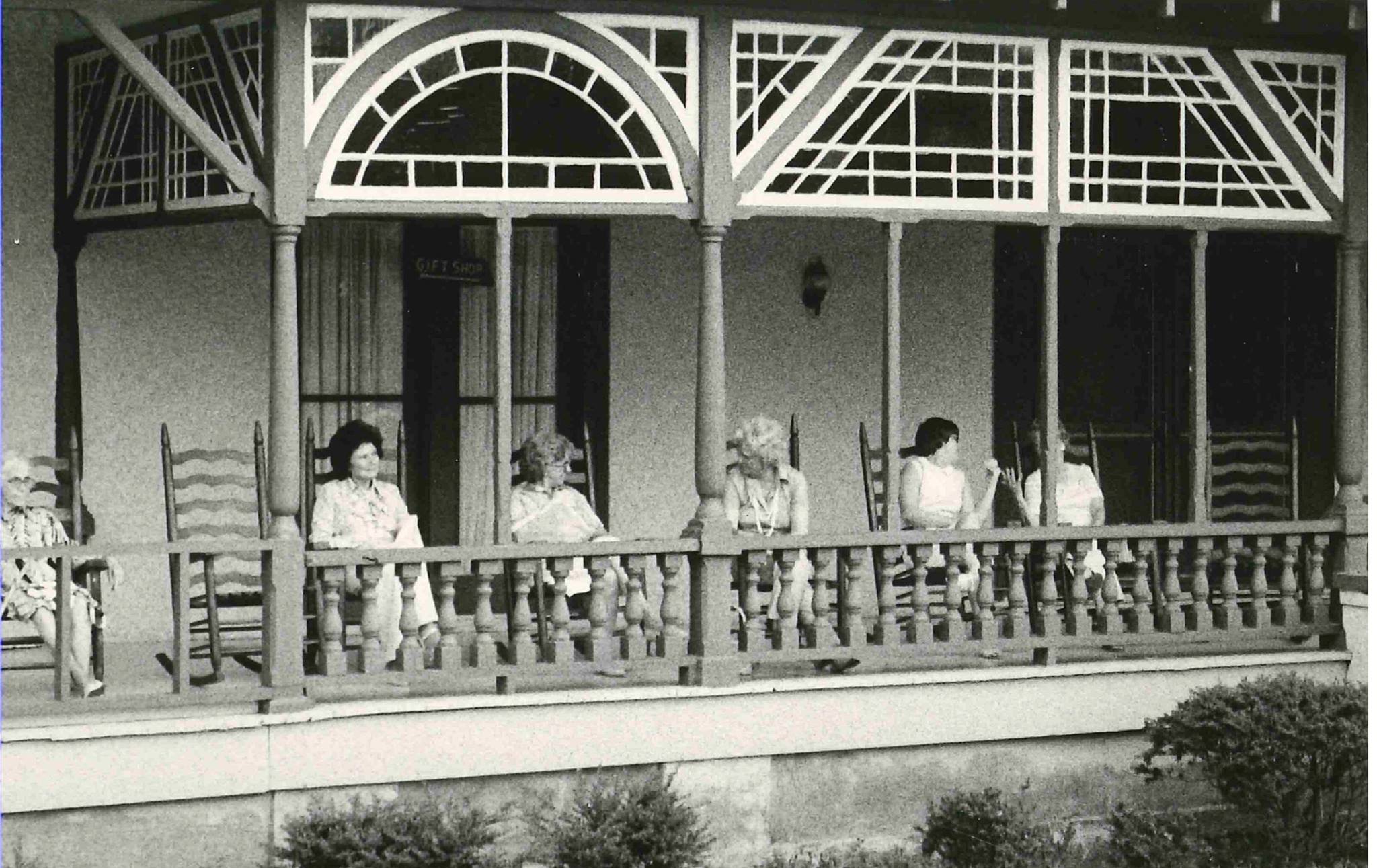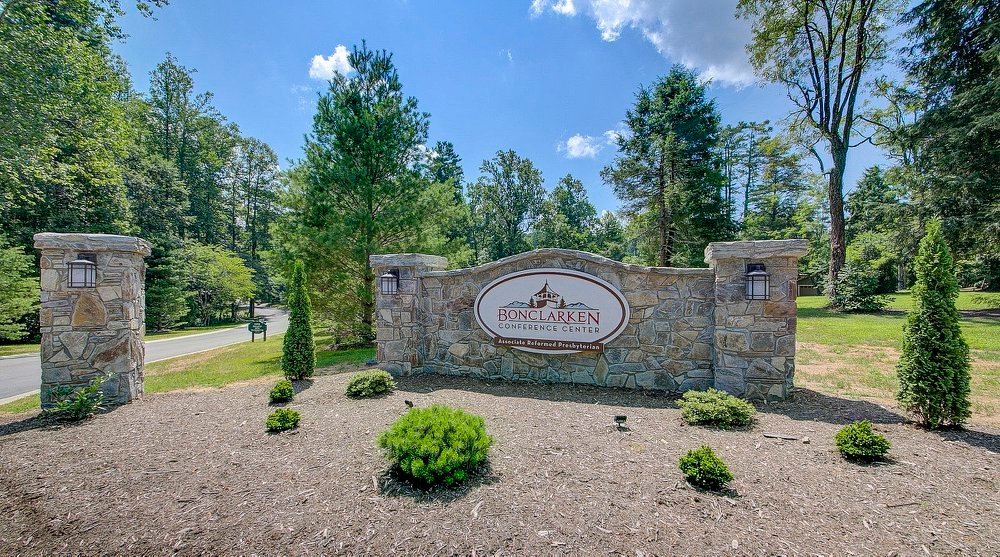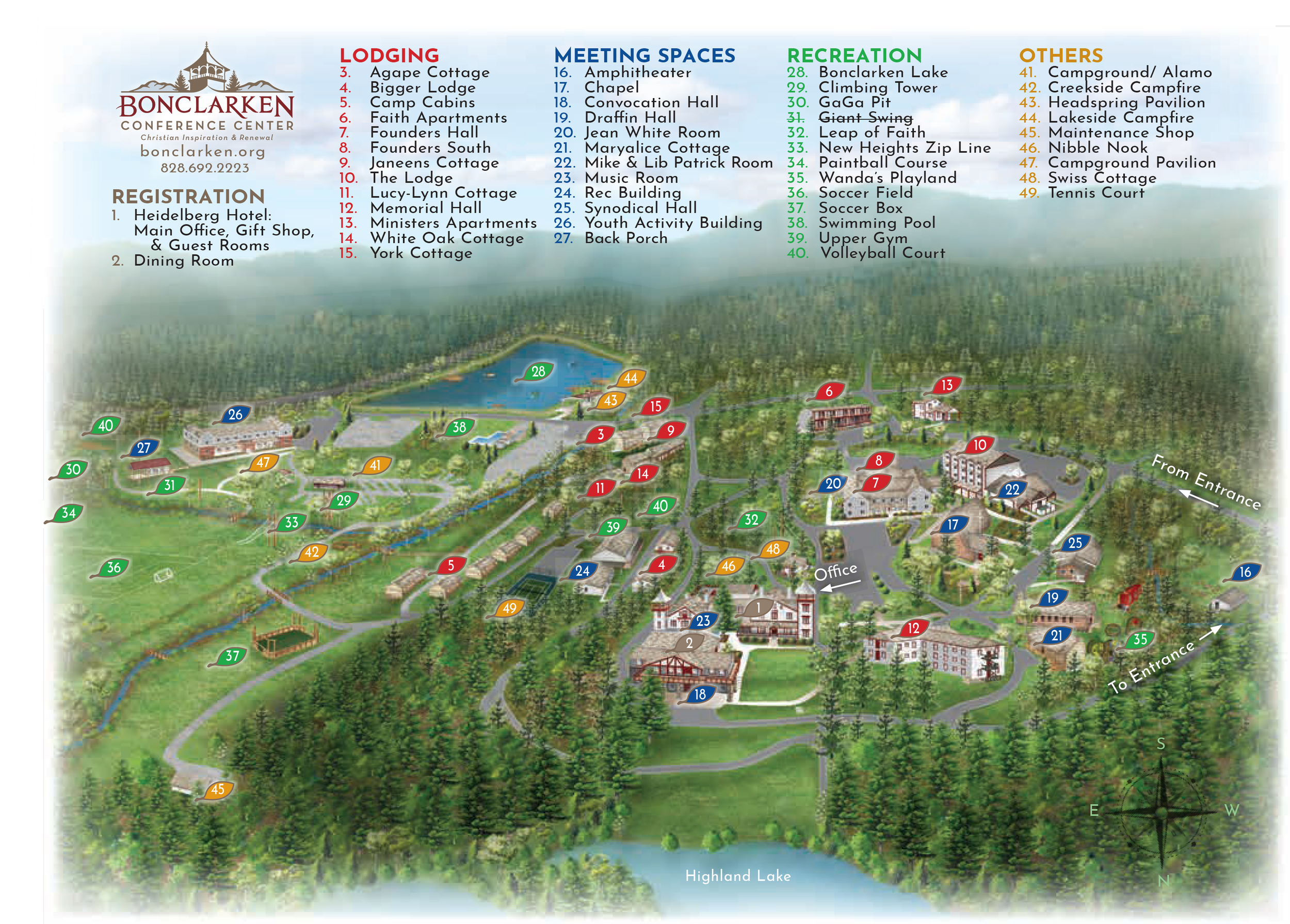Bonclarken: 100 Years of Good Clear Vision
/Robert S. Galloway, Sr. stood on the terrace of Heidelberg Gardens. A massive structure, built for a home, loomed behind him. His blue eyes looked out across Highland Lake below, across the lush green forest to the peaks of Bald Top, Bear Wallow, and Sugarloaf Mountains, and he thought to himself, “Can our little church ever own anything as beautiful as this?”
Bonclarken - A Story of Faith, Hope, and Tenacity
by Peggy Murdock
Heidelberg House
As he stood on that garden terrace in August of 1921, Robert Galloway placed himself squarely at the intersection of two extraordinary chapters in the history of Flat Rock. Behind him, and representing the past, stood the magnificent structure and intriguing history of Heidelberg House. A massive home built by Dr. Arthur Rose Guérard to placate his German-born and homesick wife, Eugenie.
Stretching out before Galloway was the future - and his dream of a spectacular new home for the summer Bible conference of the Associate Reformed Presbyterian Church. A dream that will celebrate the 100th Anniversary of its fruition in the summer of 2022.
Heidelberg House History
A rare family portrait of the Guérard family taken on the front porch of the Heidelberg House shortly after completion of the house in 1886. Pictured here are children: Arthur, Jr., Amy, Annette, Franz e., and Norman with the parents Arthur and Eugenie, Franz Engles (Eugenie’s brother) and servants
In the late 1800s, the family of Arthur Rose Guérard lived in Charleston, SC, and vacationed in Flat Rock to escape the humidity of the low-country summers. Eugenie Guérard, Arthur’s wife, enjoyed Flat Rock much better than Charleston and urged him to build a home for the family in the beautiful mountain setting which was reminiscent of her native home. (1)
Arthur Rose Guérard was the son of Octavius Jacob Guérard and Amelia L. Rose. He was a direct descendant of Jacques Guérard, a French Huguenot who brought his family to the Charles Town area of South Carolina in 1680. His maternal grandfather was Arthur Gordon Rose, who was president of the Bank of Charleston from 1850-1856.
Arthur Rose Guérard
He was raised in Charleston and went abroad with his widowed mother and grandparents after the Civil War ended. He traveled in England, Scotland, France and Germany as a young man, becoming fluent in both French and German, and graduated from St. Andrew's University in Scotland in 1871 with a MA degree in the Classics. He also completed the course of study at the Royal College of Mines in London in 1875. (1a)
He married Eugenie Engels on Feb. 23, 1878, in Germany and their first child, a son, was born in Dusseldorf in 1879. He and his wife ultimately had a total of seven children. Eugenie was the daughter of Capt. Karl Albrecht Engels and Antoinette Hurtz. According to her husband's 1889 passport application, she was born in Cologne, Germany.(1b)
Arthur and Eugenie returned to America around 1881. Upon returning to Charleston, however, Arthur soon realized that his wife did not fit comfortably with Charlestonian society due to her limited knowledge of English.(2)
Heidelberg House ca 1895
Accommodating the wishes of his wife, Arthur built the original section of the Heidelberg House in Flat Rock in 1886. Eugenie’s father designed the original building to resemble the type of home in which she had lived in Europe. Desiring his daughter to have the amenities he felt befitted her social class, he sent most of the materials found in the house today, including the floors of imported birch, oak, and linden.(3)
The chalet-style house is an example of stick style architecture popular in Europe and America in the 1800s. Stick style is a type of Queen Anne architecture characterized by embedded corner towers, wrap-around porches and spindle detailing, particularly at the gable peaks. The hardwood frame building was held together with large wooden pins. (4)
Multiple additions to the house continued until its completion in 1903. Many materials used to construct the house came from Europe, including French and German tile. Birch, oak, and linden wood offered variety in the woodwork. The Guérard family added the first tower in 1893. In addition, pebbledash stucco was added to the house around this time as well by English architect Richard Sharpe Smith - who assisted in building the Vanderbilt Biltmore Mansion in Asheville. (5)
The Guérards called their home the Heidelberg House, reflecting Eugenie’s German heritage. When the tower was added in 1893, the family decided to become permanent residents. The last addition to the house was the East wing and music room, built in 1902/03. With this final addition, the house size increased to its present-day 25,000 square feet. (6)
The house seen from Highland Lake ca 1903.
During the many years of construction and additions, Mrs. Guérard eventually depleted her husband’s resources. In its final form, the wood-frame structure included a three-story tower with two large wings, long verandas on all sides and two porte-cocheres. In all, there were 60 rooms: 45 bedrooms, 14 bath and toilet rooms, two parlors, two dining rooms, an assembly room, library, office, kitchen, pantries, storerooms, cellar, etc. It featured all the bells and whistles including hot and cold water, steam heat, open fireplaces, a lighting plant, electric bells, and a telephone system. (7)
The Guérard Family: Tragedy and Change 1900-1915
Changes were on the horizon for the Guérard family as the 20th Century dawned. New family members, financial investments, and multiple business ventures all brought new challenges and obstacles to the Heidelberg Estate until 1915.
In May 1900, Eugenie died in Flat Rock. Upon his return to Flat Rock in 1901, Dr. Guérard brought a new wife named Madelaine née DiMarcarellos. Madelaine was also of German descent and together she and Arthur also had seven children.
In 1908, the Guérards opened their home as a summer hotel. A couple of years later, with the rise of sanatoriums, Dr. Guérard used his medical training acquired in 1892-95 at the Bellvue Hospital Medical College in New Your and opened a tuberculosis sanatorium. Although a timely idea given the prevalence of the disease, census records from 1910 show only a small number of patients came to the Heidelberg. (8)
When the sanatorium venture proved untenable, Madelaine proposed operating a casino on the property — which caused a big uproar in Flat Rock. (9)
In one last attempt to preserve the estate, the Guérards followed the example of other local schools by planning to open the Heidelberg Academy for Girls with German tutors in 1914. Their timing was unfortunate, however, as the start of World War I generated a degree of anti-German sentiment that prevented the school from opening.
Promotional postcard for the Heidelberg Hotel.
Out of options and ideas, the Guérard family decamped from Flat Rock to New York where Arthur had studied medicine. (10) They lived in NYC where he worked as a Public Health Officer. Mr. Guerard wrote or co-wrote several books and articles pertaining to mining and the medical field as well as numerous papers outlining the history of his family, including his own memoir, "Reminiscences of a Great Grandfather Illustrating the Life and Experiences of an American Gentleman of the Old South", c. 1937 and privately printed in a limited quantity for the 2012 Guerard Reunion at Bonclarken, the former Heidelberg House in Flat Rock, NC. (10a)
Transition 1915 - 1922
The house underwent several changes in ownership before the Heidelberg House and the 63 acres surrounding it became part of the ARP denomination’s conference center in 1921.
Edward Stuart and Robert Galloway
In 1915, the Associate Reformed Presbyterian Church began holding summer Bible conferences at Linwood College located at the foot of Crowder's Mountain, near Gastonia, NC. The conferences were very popular and well attended. However, in 1920, the conference planners learned the college was to be sold due to financial difficulties. Efforts to buy the facility were unsuccessful, so a new meeting location was needed.
Looking for a location with cooler summer temperatures, the mountains of western North Carolina were selected to begin the search. Providence led a realtor in Hendersonville, NC to suggest a particular location: a beautiful sixty-three acre estate, containing a massive home and the Heidelberg Gardens, for sale in Flat Rock.
The location was perfect for the conference and the estate was purchased on August 31, 1921. (11)
After his successful trip to the mountains in August 1921 to look for property, Robert Galloway wrote a three-page telegram to Edward C. Stuart telling him of the wonderful find in Hendersonville, the Heidelberg Estate and Gardens. Soon after seeing the property, Galloway and others gathered at the Heidelberg Estate property and decided to buy it for their new conference assembly grounds.
Heidelberg House was about to embark on a new and much more stable chapter in its long and fascinating history.
Establishing Bonclarken
Sallie Miller Brice who gave Bonclarken its name.
Early Bonclarken leaders held a contest within the ARP Church to name the new Assembly Grounds. Mrs. Sallie Miller Brice of Chester, SC submitted the winning entry. She used the words bon from Latin bonus, meaning good, clar from Latin clarus, meaning clear, and ken from Scotch, meaning vision. So her propoased name “Bonclarken” literally means good, clear vision. (12)
In November 1921 the name Bonclarken was officially voted on and approved. Besides Bonclarken, many other names were submitted such as Rutherglen, Torwood, Mountarp, Dromtochty, Seceder Heights, Bon-Erskine Retreat, Mount Psalmody, and many others. (13)
Bonclarken’s First 100 Years
A private corporation was established in 1921 to run the assembly grounds during the early years. To raise funds for the ground, early Bonclarken leaders sold land plots to interested individuals, thus creating the Bonclarken property owners association.
In the summer of 1922, Bonclarken held its first conferences. The very first conference held on the Bonclarken grounds was a Young People’s Christian Union and Sabbath School on August 4-12, 1922.
A year after these initial conferences, an entrance gate was added to alert guests to the road to the assembly grounds, This road was not paved until the early 1950s. Garrison hall was built the same year to accommodate growing numbers at the summer Bible conferences. Ministers cottage, completed in 1928, provided a place of rest for ministers and their families. (14)
Bonclarken conference in the 1930s
In addition to the many conferences held at Bonclarken, Camp Bonclarken began operations in 1957 and had a turnout of 66 campers and 4 counselors. In 1958, Bonclarken Lake was completed allowing the added activities of fishing, boating, and swimming, for the youth and families who came to Bonclarken. The popular Bonclarken Music Conference has been happening each summer for over 50 years. (15)
This year, 2022, marks the 100th Anniversary of Bonclarken and the conference center will celebrate with a tour of homes on May 28th and a centennial celebration and worship service on July 2nd.
One hundred years after hosting its first conferences, thousands of people come through Bonclarken’s gates each year to attend retreats, meetings, conferences, weddings, camps, family reunions, vacations, or weekend getaways. And no one likely leaves the Associate Reformed Presbyterian Conference Center grounds without seeing The Heidelberg Hotel and experiencing an important part of Flat Rock’s historic heritage.
Heidelberg Hotel today. With 19 rooms and four suites, the Hotel is large enough to accommodate groups up to 39. The historic construction and character of the building have been preserved, so heating and air-conditioning is not present. Consequently, the Hotel is only made available for lodging from May through September.
Heidelberg House Images
Bonclarken History
References
(1) A Plan to Save Bonclarken’s Beloved Hotel by Delores McDonald; ARP Magazine, March 14, 2013. http://arpmagazine.org/plan-to-save-bonclarkens-beloved-hotel/
(1a) Arthur Rose Guerard; geni.com
(1b) Eugenie Engels, geni.com
(2) A History of Heidelberg House and Bonclarken courtesy of Bonclarken Conference Center.
(3) A Plan to Save Bonclarken’s Beloved Hotel by Delores McDonald; ARP Magazine, March 14, 2013. http://arpmagazine.org/plan-to-save-bonclarkens-beloved-hotel
(4) A Plan to Save Bonclarken’s Beloved Hotel by Delores McDonald; ARP Magazine, March 14, 2013. http://arpmagazine.org/plan-to-save-bonclarkens-beloved-hotel/
(5) A History of Heidelberg House and Bonclarken courtesy of Bonclarken Conference Center.
(6) A Plan to Save Bonclarken’s Beloved Hotel by Delores McDonald; ARP Magazine, March 14, 2013. http://arpmagazine.org/plan-to-save-bonclarkens-beloved-hotel/
(7) Flat Rock Summer Camps, by Missy Izard Schenck; Charleston Mercury. https://www.charlestonmercury.com/single-post/2020/07/01/Flat-Rock-summer-camps
(8) A History of Heidelberg House and Bonclarken courtesy of Bonclarken Conference Center.
(9) Flat Rock Summer Camps, by Missy Izard Schenck; Charleston Mercury. https://www.charlestonmercury.com/single-post/2020/07/01/Flat-Rock-summer-camps
(10) Facebook Page, Bonclarken Conference Center. https://www.facebook.com/bonclarken
(10a) Arthur Rose Guerard; Geni.com
(11) A Plan to Save Bonclarken’s Beloved Hotel by Delores McDonald; ARP Magazine, March 14, 2013. http://arpmagazine.org/plan-to-save-bonclarkens-beloved-hotel/
(12) Facebook Page, Bonclarken Conference Center. https://www.facebook.com/bonclarken
(13) A History of Heidelberg House and Bonclarken courtesy of Bonclarken Conference Center.
(14 A History of Heidelberg House and Bonclarken courtesy of Bonclarken Conference Center.
(15) Facebook Page, Bonclarken Conference Center. https://www.facebook.com/bonclarken
(16) A Plan to Save Bonclarken’s Beloved Hotel by Delores McDonald; ARP Magazine, March 14, 2013. http://arpmagazine.org/plan-to-save-bonclarkens-beloved-hotel/









